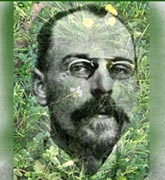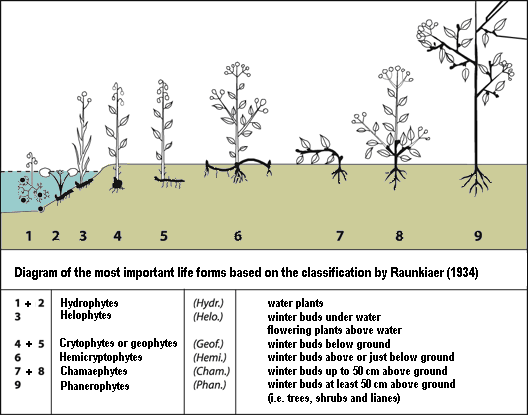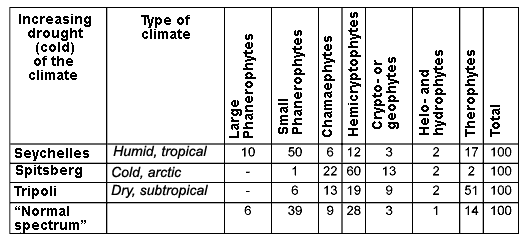
Raunkiær (1934) has classified plants according to the place where the growth point is located during the less favorable seasons, provided the plant maintains the capability to survive these difficult conditions (see list and figure here below). Depending on the place on earth, this unfavorable period can be for example in the cold winter period or in the dry summer time. In our regions the growth point in the unfavorable season correspond mostly to winter buds. The following ordering can be distinguished:
- Epiphytes: grow on or are attached to other living plants{Gr. epi = above; phyton =plant}
- Phanerophytes: growth point in unfavorableseason at least 50 cm above ground level, often on stems (e.g. trees, bushes, lianes){Gr. phanero = visible}
- Chamaephytes: growth point in unfavorable seasons up to about 50 cm above ground level (e.g. many perennial herbaceous plants){Gr. chamai = close to the ground}
- Hemicryptophytes: growth point in unfavorable season above or just below the ground {Gr. hemi = half; crypto = hidden}
- Therophytes: as seed (annual plants)
- Cryptophytes or geophytes: growth point in unfavorable season below ground level (e.g. Crocus) {Gr. geo = earth}
- Helophytes: growth point (winter buds) below water, flowering parts above water (e.g. Tufted Sedge){Gr. helos = marsh}
- Hydrophytes: water plants (bijv. White Water Lily){Gr. hydros = water}
These life forms are not evenly distributed over the earth. Each climatic zone has its own spectrum of life forms. In the tropics relatively many Phanerophytes (trees) occur, in an arid climate (desert) relatively numerous annuals (Therophytes) are encountered, and in a more temperate zone Cryptophytes and Hemicryptophytes (rosette plants, plants with rhizoids, bulbs, turnips) are relatively abundant.
| Most important life formsaccording to Raunkiaer |
 |
By determining which contribution the various life forms have to the flora of a certain region, one can obtain an ecologicalspectrum or lifeforms spectrum which reflects a certain relationship with the climate of an area (see table here below). Noticeable is the largecontribution of trees and shrubs (phanerophytes) in the tropics. In the cold arctic climate phanerophytes are almost absent, while the proportion of plants with buds just above ground, at the surface or in the soil is large (95 % Cham+Hemi+Geo). In the dry subtropical climate (desert, arid areas) the annuals (Therophytes) occupy a large place in the vegetation.
| Spectrum of lifeforms according to Raunkiaer in various climate zones |
 |
|
Indicated is the percentage plants that belongs to a certain life form. A " normal spectrum" regards the distribution of all higher plants together. Largephanerophytes: trees; smallphanerophytes: shrubs and (dwarf)bushes.
|
It is important, however, to realize that many of the current vegetations are not in a climax-stage. Man has had a strong influence on the composition of many biotopes. Yet, Raunkiær' system has provided a tool to think about an essential, so far unresolved question: how does it come that in very different flora region plants occur with a quite predictable spectrum in life forms?
Reference: Raunkiær (1934) The Life Forms of Plants and Statistical Plant Geography.Oxford University Press.







